Canon EOS R6 Mark II review
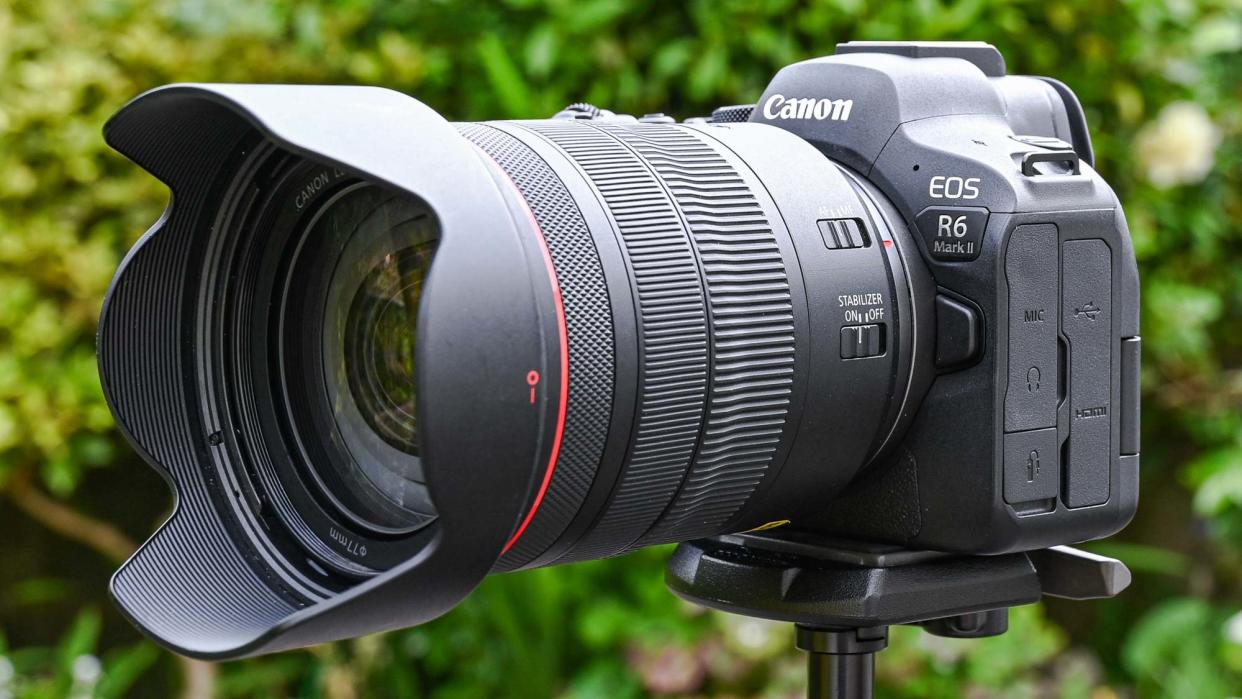
Canon EOS R6 Mark II: Specs
Sensor: 24.2MP full-frame Dual Pixel CMOS AF II
Image processor: DIGIC X
Image stabilization: Up to 8 stops (lens dependent) + Movie Digital IS
AF points: 4,897-point
Viewfinder: 0.5-inch OLED EVF, 3.69 million dots
Display: 3.0-inch Vari-angle colour LCD Touch Screen, 1.62 million dots
ISO: 100-102,400 (expandable to 50-204,801)
Max video resolution: 4K at 60p, 50p, 30p, 25p, 24p
Ports: USB type-C, micro HDMI, mic mini jack, headphone mini jack, hot shoe, E3-type remote control, multi-function hot shoe
Storage: 2x SD/SDHC/SDXC UHS-II
Wireless: Wi-Fi 5/2.4GHz, Bluetooth 5.0
Shooting speed: 12fps mechanical, 40fps electronic
Battery life (CIPA): 760 shots LCD, 450 shots viewfinder
Size/weight (body inc battery, card): 5.45 x 3.87 x 3.48 inches; 1.5 lbs
The Canon EOS R6 Mark II has a tough act to follow. We were thoroughly impressed by the original EOS R6, with a couple of reservations. It ushered in Canon’s much vaunted deep-learned AI autofocus system and added highly effective IBIS (In-Body Image Stabilization), which was a glaring omission in Canon’s original EOS R and EOS RP full-frame mirrorless cameras. However, the 20MP image sensor had a meager megapixel count by recent standards and the camera was prone to overheating when shooting 4K UHD video.
Both of these were significant minus points for what was designed as a hybrid camera for shooting stills and video, but the Mark II addresses both issues while adding a wealth of further upgrades. As such, the new model should more than satisfy the demands of professional and enthusiast hybrid shooters. With seamless switching between stills and video, it’s ideal for professionals shooting weddings, action, sports or wildlife. The R6 Mark II is also one of the best mirrorless cameras for enthusiasts in those areas, or indeed in any genre of photography, although it’s certainly on the pricey side for those only wishing to take stills and video of vacations, family and pets. Find out more in our Canon EOS R6 Mark II review.
Canon EOS R6 Mark II review: Price and availability
The Canon EOS R6 Mark II is significantly less expensive than the 45MP EOS R5 and much cheaper than the flagship EOS R3 — the latter having a similar 24.1 megapixel resolution but boasting a more high-tech stacked, back-illuminated image sensor and a built-in vertical grip for natural ergonomics in portrait as well as landscape orientation shooting.
The flipside is that the EOS R6 Mark II is pricier than the more basic EOS R8 full-frame mirrorless camera, as well as the older EOS R and EOS RP, which were Canon’s first foray into the full-frame mirrorless market. On its own, the EOS R6 Mark II has a body-only price of $2,499/£2,779.
For a few dollars more, you can buy the camera as a kit with the RF 24-105mm F4-7.1 IS STM lens at $2,799/£3,129. It’s a compact and lightweight zoom lens with the additional benefit of a 0.5x macro facility for extreme close-ups. In our tests, however, the quality and performance of this lens can’t make the most of what the EOS R6 Mark II has to offer. A much better kit option, budget allowing, is to buy the camera with the more pro-grade RF 24-105mm F4L IS USM L-series lens, at $3,599/£3,999. There’s no getting around it, this is a pricey camera in any guise, which makes sense when considering its advanced target audience of pros and enthusiasts.
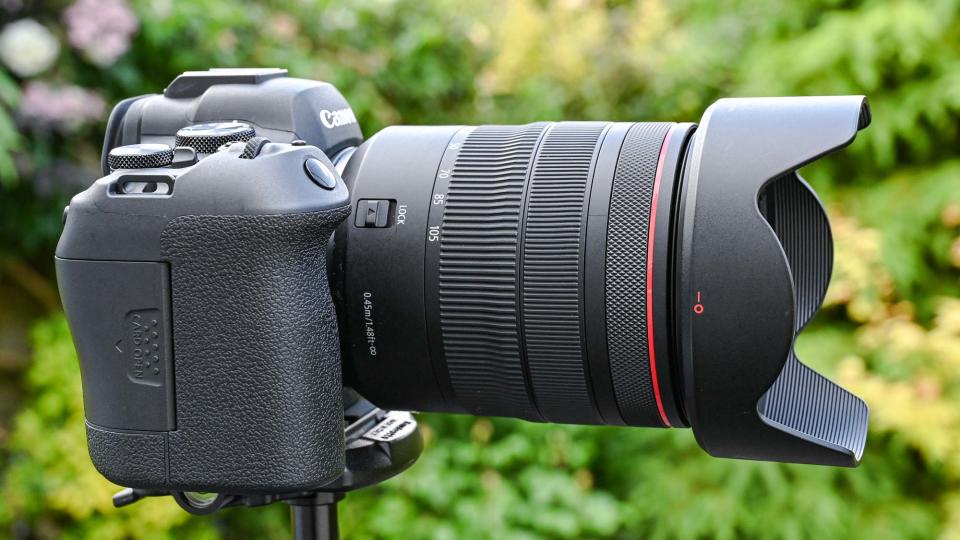
If you’re just looking for a tool for casual photos and videos of friends and family, though, or to dabble purely in photography, you’d be better off looking at a camera in the more affordable mid-range market, such as the Canon EOS R8, Canon EOS R7 or the Fujifilm X-T30 II.
Canon EOS R6 Mark II review: Design
The Canon EOS R6 Mark II feels pretty chunky for a full-frame mirrorless camera. It’s a little shorter and shallower than the EOS 6D Mark II DSLR, and both are a practically identical weight of 1.5lbs. An upside is that handling feels very natural thanks to its large ergonomic grip, and it feels well-balanced when using large lenses.
While looks likely won’t matter to its target market of hardcore enthusiasts and semi- or fully professional users, it’s worth pointing out that the R6 Mark II exemplifies Canon’s current lack of adventurousness in design ethos — save it’s R6 branding, this camera would be indistinguishable from Canon’s other R-System bodies to all but the trained eye. If you want a camera that stands out, Canon isn’t the manufacturer for you, and you may be best off with something a little more stylish like the APS-C Fujifilm X-T5.
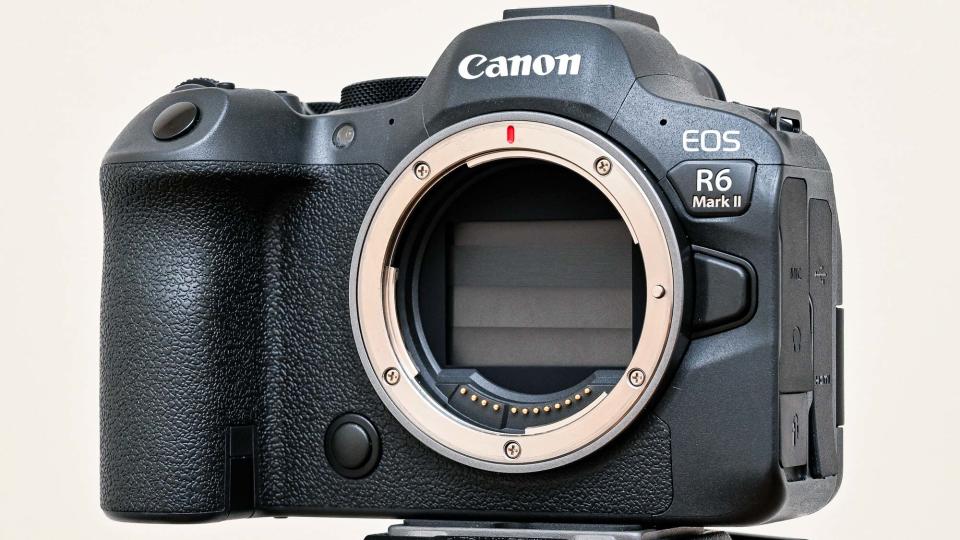
Build quality feels robust, though. The construction is based on a fiberglass-reinforced polycarbonate shell on a sturdy aluminum chassis, complete with an extensive set of weather-seals. As you’d expect from a camera at this price, the electronic viewfinder is a high-quality item, featuring a 0.5-inch, 3.69 million-dot OLED screen that produces a generously large and finely detailed viewing image. As with any electronic viewfinder, it’s not quite as perfect as the optical viewfinder of a DSLR for panning, but it’s very smooth nonetheless. And it’s a big bonus being able to preview the effects of exposure compensation, white balance adjustments and color profiles before and as you shoot.
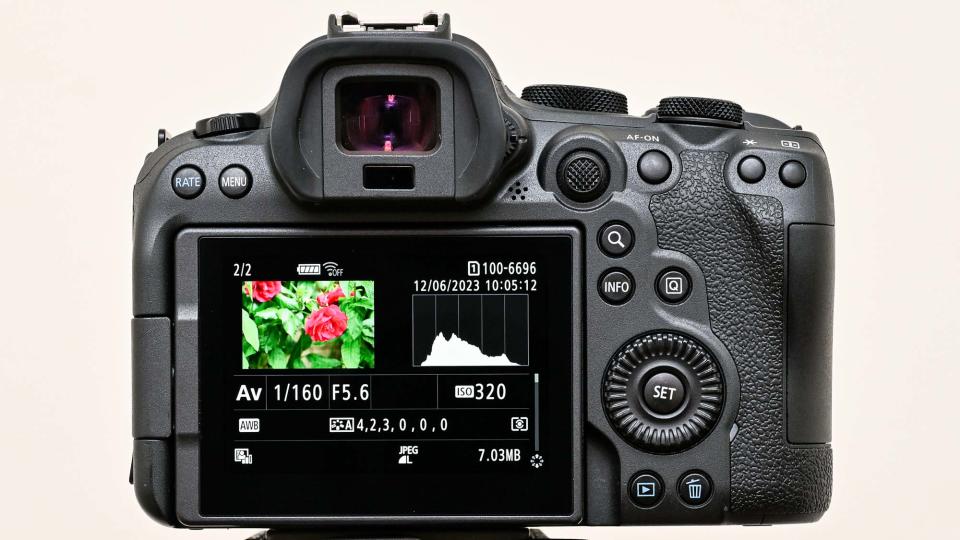
The visible information in the viewfinder screen can be customized to include the likes of a histogram, leveling guide and extended shooting parameters. The same goes for previewing and reviewing images on the rear touchscreen. Again, it’s a high-end display: a 3.0-inch LCD with a highly detailed 1.62 million-dot resolution and very natural color rendition.
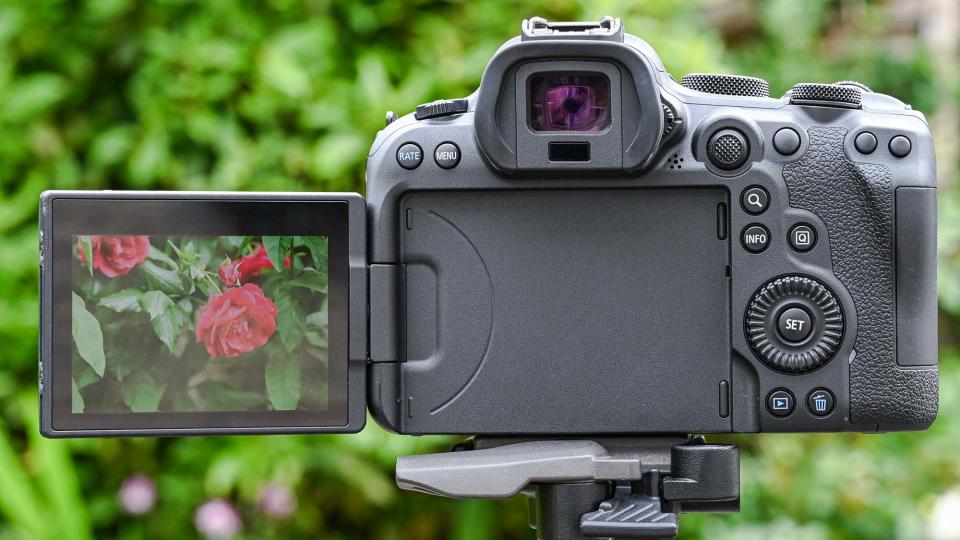
With stills and video both firmly in mind, the camera is well-connected. Weather-sealed rubber flaps on the left hand side of the body give access to sockets for a stereo mic, stereo headphones, mini-HDMI, USB-C and a remote controller (Canon E3-type socket). An upgrade in the Mark II is that it features Canon’s new ‘Multi-Function Shoe’ instead of a conventional hot-shoe. Going beyond the regular attachment of a flashgun, this gives further options of connecting smart accessories including the Canon DM-E1D Stereo Microphone and AD-P1 Smartphone Link Adapter for Android smartphones, bringing new workflow possibilities with the Canon Mobile File Transfer App.
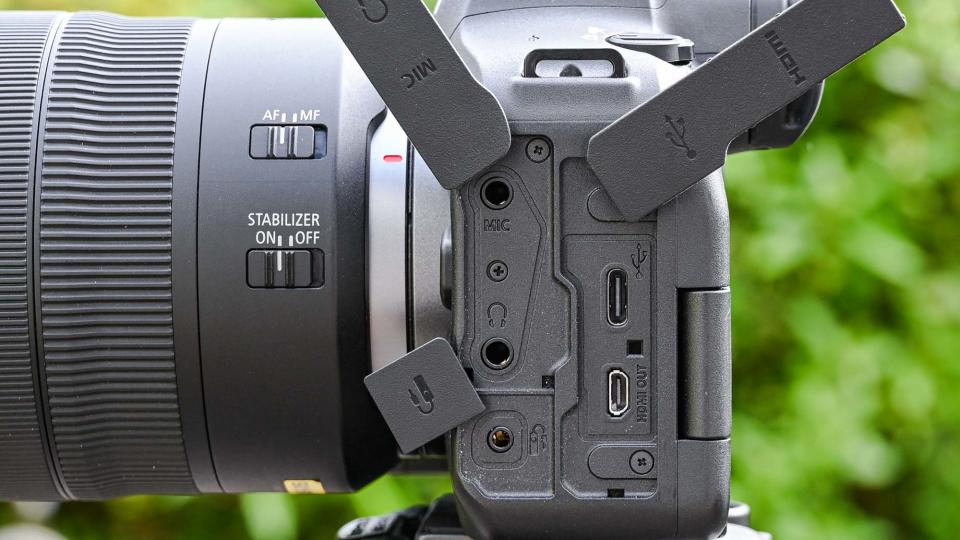
For camera-based storage, there are dual SDXC UHS-II memory card slots. As usual, these enable you to create instant backups as you shoot, on two different cards, or to use separate cards for different types of file — for example saving stills on one card and video files on the other.
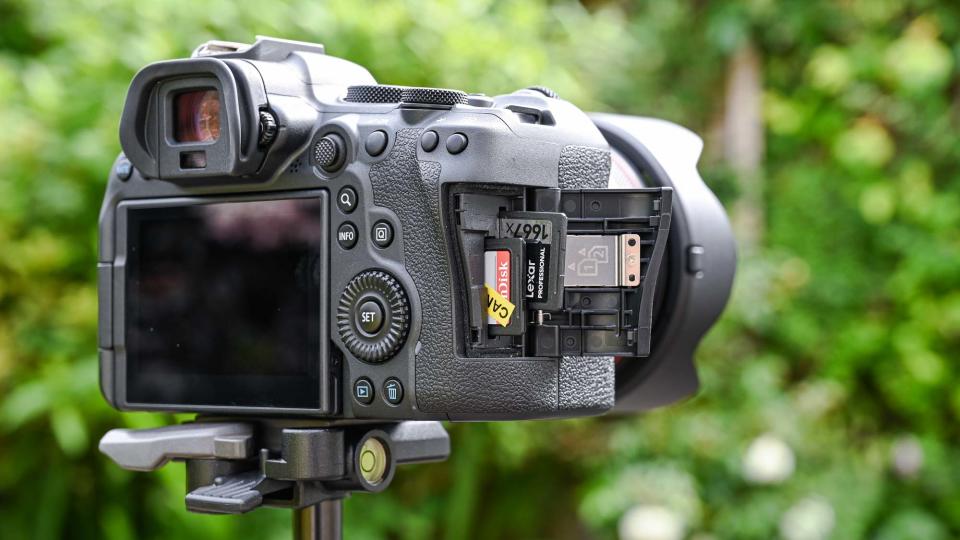
You can also use the secondary card for overflow. There are no CF Express ports, unlike full frame rival the Nikon Z 6II, which may disappoint some harder-core videographers using the R6 Mark II as a B cam — although SDXC will be plenty fast enough for the hybrid market this camera is primarily aimed at.
Canon EOS R6 Mark II review: Controls
The Canon EOS R6 Mark II handles intuitively, having a fairly clean and uncluttered layout of control buttons and dials. It’s fairly similar to that of the original EOS R6 but the on/off switch is relocated on the right hand side of the top panel and a new addition on the left is a stills/video switch. It works really well when you want to switch back and forth between stills and video capture, enabling you to make the change with a simple flick of the thumb.

Unlike in the pricier EOS R5, there’s no OLED info screen on the top panel. In its place, you get a conventional shooting mode dial. This gives ready access to PASM shooting modes, creative effects and custom modes.
While Canon’s high-end DSLRs typically featured a rank of buttons for quick access to the likes of white balance, autofocus mode and metering mode, on the R6 Mark II there’s the usual heavier reliance on the Quick menu — a streamlined menu that you can call up with a press of the Q button on the rear panel — something we’ve become used to seeing in mirrorless cameras. There’s also a more conventional menu layout that’s available via the Info setting, and Canon users will find the familiar M-fn (Multi-function) button placed just behind the shutter release button instant access to a range of core shooting settings.
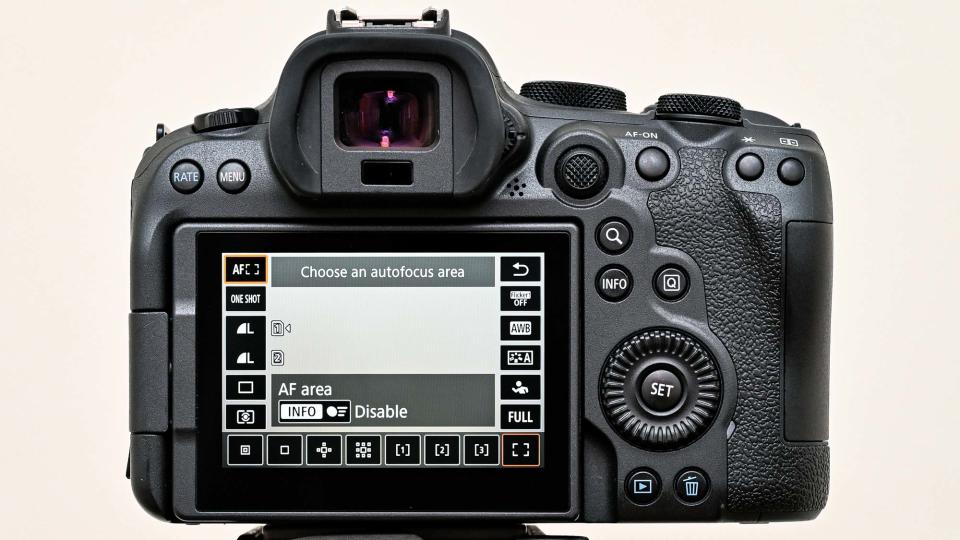
Further back on the top panel, the video shooting start/stop button falls neatly under the finger to allow instantaneous recording. Similarly, a joystick controller on the rear panel falls nicely under the thumb, ideal for selecting different autofocus points as well as for navigating menus. If you’re composing shots on the rear touchscreen, you can just press the relevant point on which you want to autofocus, another modern day staple of mirrorless camera design.
Front and rear control dials are also well positioned, as is the lower rotary control dial lower further down on the back panel. All in all, the learning curve for accessing the finer points of camera control is both short and shallow.
Canon EOS R6 Mark II review: Performance
The Canon EOS R6 Mark II builds on Canon’s excellent reputation for natural color rendition. A range of different ‘Picture Styles’ is on hand to enhance the likes of portraits and landscapes, plus an Auto option that selects the appropriate picture style for the subject matter, as you shoot. Naturally, if you shoot in RAW quality mode, you can keep or change the picture style at the editing stage, as well as changing the white balance, exposure value and other parameters.
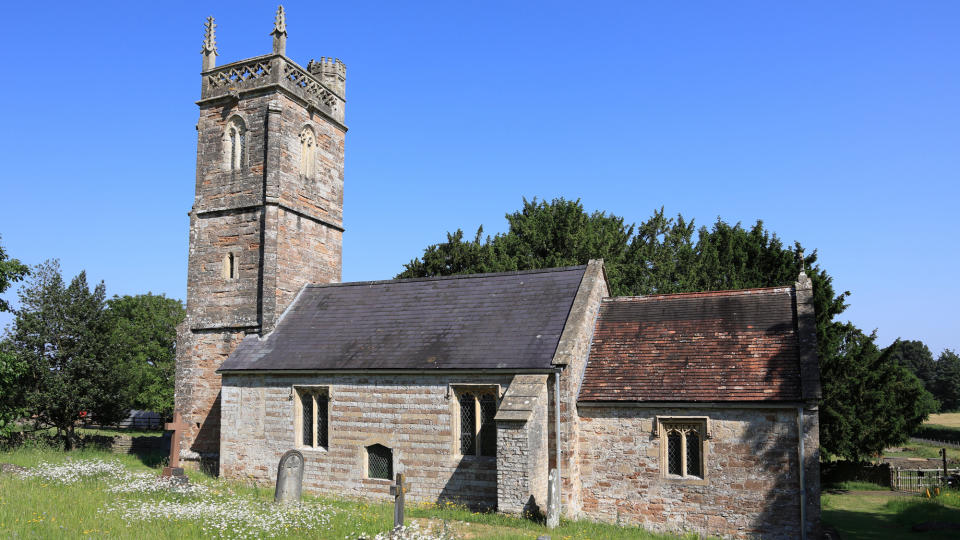
Canon made a big deal about its deep-learned AI autofocus system when it launched the original EOS R6 and companion EOS R5 cameras. It’s not true ‘AI’, as the camera doesn’t learn new tricks or improve its autofocus performance as it’s used. Instead, the system was developed to recognize subjects like people and animals, based on scanning in vast numbers of existing shots. The system has been enhanced to include more specific animals (dogs, cats, birds and horses) plus vehicles (racing cars, motorcycles, aircraft and trains).
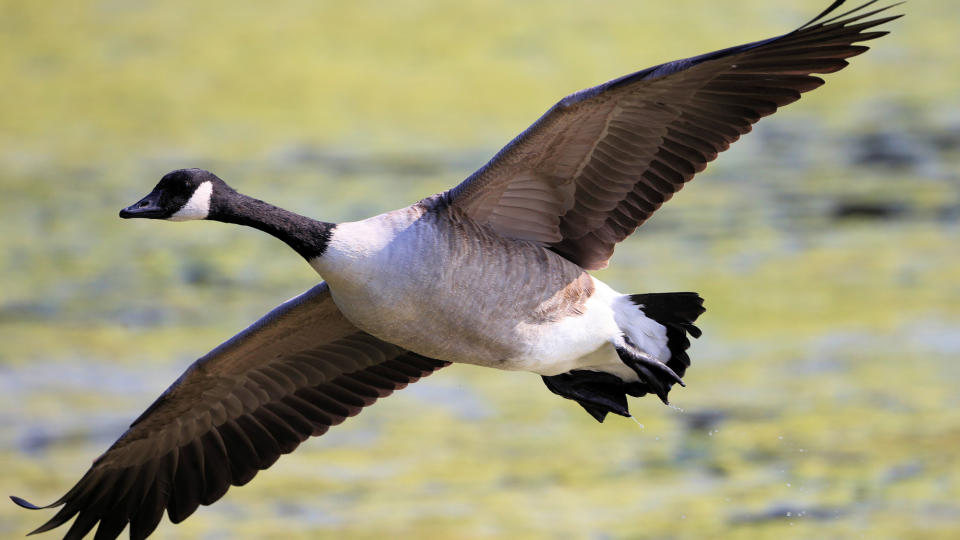
While similarly smart autofocus systems are available in many recent competing cameras from the likes of Nikon, Sony and Fujifilm, the subject recognition and tracking abilities of the EOS R6 Mark II’s autofocus system are pretty phenomenal. For example, it’s able to recognize people’s faces even if they’re wearing goggles of a crash helmet, or pick out the cockpit of an aircraft. Even for erratically moving subjects, autofocus simply locks on and won’t let go, ensuring an incredible hit rate with consistently sharp shots.

This makes the EOS R6 Mark II a prime candidate for action, sports and wildlife photography. Another plus point here is that, while matching the fast stills burst rate of the original EOS R6 at up to 12fps when using the mechanical shutter, it leaves the older camera for dust if you switch to the electronic shutter, where a blistering 40fps is on hand versus 20fps in the original camera.
When it comes to buffer depth at the maximum 12fps shooting rate with the mechanical shutter, there’s capacity for 1,000 shots or more when using a fast SDXC UHS-II card, in JPDG, HEIF and Compressed RAW quality modes. That shrinks to a still-generous 140-190 shots at 40fps with the electronic shutter. Another neat use of the buffer is that you can fire a burst of up to 15 RAW quality shots in the half-second before fully pressing the shutter-release button, which can help you avoid missing definitive moments.
The electronic shutter itself is good for speeds up to 1/16,000th of a second for freezing even super-fast action. Meanwhile, the HEIF image quality option is a useful addition, giving 10-bit color depth compared with 8-bit for JPEG. This gives you more latitude at the editing stage for reining in highlights and boosting shadow detail. This makes a lot of sense for professional users, especially in the context of shooting to a back-up SD card — if the worst befalls you and your RAW files are lost, at least you’ll have more to work with than just JPEGs.

Another factor that ensures a superb hit rate even in difficult shooting conditions is the 5-axis in-body image stabilizer system. In combination with many of Canon’s optically stabilized RF lenses, including both of the RF 24-105mm kit zoom lenses, you get a full 8-stops of image stabilization. Surprisingly, that also holds true for some lenses that don’t feature optical stabilization at all, including the RF 28-70mm F2L USM and the RF 85mm F1.2L USM. You’ll even get 7-stop stabilization with the low-budget RF 50mm F1.8 STM, which again doesn’t feature optical stabilization.

The EOS R6 Mark II features a 24.2MP full-frame Dual Pixel CMOS AF II sensor, paired with Canon’s DIGIC X processor. Sensor-wise, this is a significant jump from the 20.1 megapixels in its predecessor, but is still relatively modest for a full-frame camera. As such, if you’re shooting for large format printing, you may want to look at something with a higher resolution sensor, like the Sony A7 IV.
An upside of the modest megapixel count is that the individual photosites on the image sensor (that equate to pixels in the final image) are physically larger. This enables them to gather more light, resulting in relatively noise-free image quality at very high ISO settings. Like the original R6 then, the R6 Mark II is designed for and does very well in low light, and has a wide sensitivity range to match: ISO 100-102,400 in standard trim, expandable to 50-204,801. Another performance boost for low-light shooting is that the autofocus system can work in almost complete darkness, right down to -6.5 EV. For context, that’s darker than shooting at night under a half-moon with no other lighting.
And just a word on stamina, while we’re talking performance. The EOS R6 II has improved battery life compared with the original model, now rated at 450 shots when using the viewfinder, and 760 shots with the LCD, compared with 380/510 shots on the first R6.
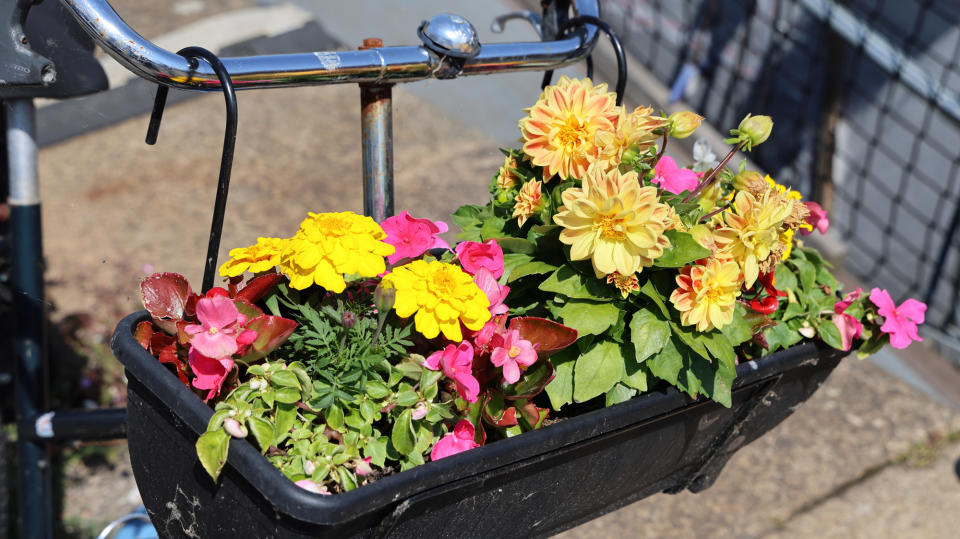
Canon EOS R6 Mark II review: Video
The Canon EOS R6 Mark II is capable of 4K UHD at up to 60p and, unlike the original EOS R6, that’s using the full width of the sensor without a 1.07x crop factor. You can also shoot 4K UHD internally from oversampled 6K capture, which can help to reduce moire patterning and false color.
A vital upgrade for serious videographers is that there’s no longer a 30-minute time limit per take. The time restriction has been removed and Canon quotes a maximum duration of six hours for a single clip. Naturally, power and storage limitations apply. And while the overheating issue of the original EOS R6 has essentially been fixed thanks to new circuitry, there’s still a 40-minute timeout at the highest video resolution and frame rate of 4K 60p, but that’s still twice as long as in the previous model.
You also get the option of using YCbCr4:2:0 8-bit or YCbCr4:2:2 10-bit sampling, plus the Canon Log 3 profile and HDR-PQ recording, giving serious flexibility with color and dynamic range in post-production. Hook up an external recorder like the Atomos Ninja V+ via the HDMI port and you can shoot 6k at up to 60p as ProRes RAW or 3.7k RAW with crop. For slow-motion, the Mark II tops out at 180fps video capture at 1080p Full HD, compared with 120fps for the original R6.

As you’d expect considering the lower purchase price, you don’t get the stacked, back-illuminated image sensor that’s featured in the flagship EOS R3. So how does that affect video performance? As with shooting stills with the electronic shutter, each frame is recorded line by line and it naturally takes a certain amount of time for the sensor to work its way from the top to the bottom of the frame. During this time, fast-moving subjects will naturally have moved on, giving rise to the ‘rolling shutter’ effect which can give them an irregular and unrealistic shape. Conventional image sensors have a slower read-out speed than higher-tech sensors, so the effect can be more noticeable. Sony cameras in particular have been notoriously bad in this respect, but the EOS R6 Mark II does remarkably well to keep the rolling shutter effect to a minimum.
The bottom line is that video performance is excellent, the camera delivering superb quality. Again, the advanced autofocus system helps to keep people, animals and vehicles accurately in focus as they move around throughout a take. The camera also features auto-correction for focus breathing — a boon for anyone using this camera with cheaper lenses. And to avoid the shakes in handheld shooting, you’ve got the option of highly effective Movie Digital IS (with a slight crop factor) in addition to sensor-shift and optical stabilization, the latter where featured in the attached lens.
Canon EOS R6 Mark II review: Verdict
The Canon EOS R6 Mark II is a spectacular hybrid camera that works equally well for stills and video, with seamless switching between the two. Indeed, if you’re a fan of 16x9 landscape orientation stills (we are), you can output 8.3MP stills from a video clip as frame grabs.
For straight stills shooting, the camera has a 25 per cent increase in megapixel count over its predecessor, putting it on a par with competitors like the Nikon Z 6II and Sony A7 III. And while it doesn’t have the 45MP resolution of other competitor cameras in this price range, there are upsides. Image quality is squeaky-clean even at stratospheric ISO settings, ideal for ambient indoor portraiture and wedding photography, where you need to keep fairly brisk shutter speeds to avoid motion blur – no amount of image stabilization can counteract that. And for static subjects, image stabilization has up to 8-stop effectiveness, so you can generally forget about using your tripod. The relatively modest file sizes from 25MP shots make storage much more manageable and RAW files faster to process.
For action, sports and wildlife, the EOS R6 Mark II has tenacious autofocus tracking abilities and a blistering 40fps maximum drive rate, along with a cavernous buffer depth. We like that it’s not overly compact but big enough to feel like a ‘proper’ camera, really comfortable and natural in the hand, and with superb handling characteristics.
Perhaps the only drawback to the R6 Mark II is its price. Pushing well over $3,000 with a lens attached, this camera is designed for only the most hardcore enthusiasts, and is certainly geared more towards emerging hybrid professionals. All in all, though, the EOS R6 Mark II is a real winner that excels in just about any and every genre of photography and videography.
